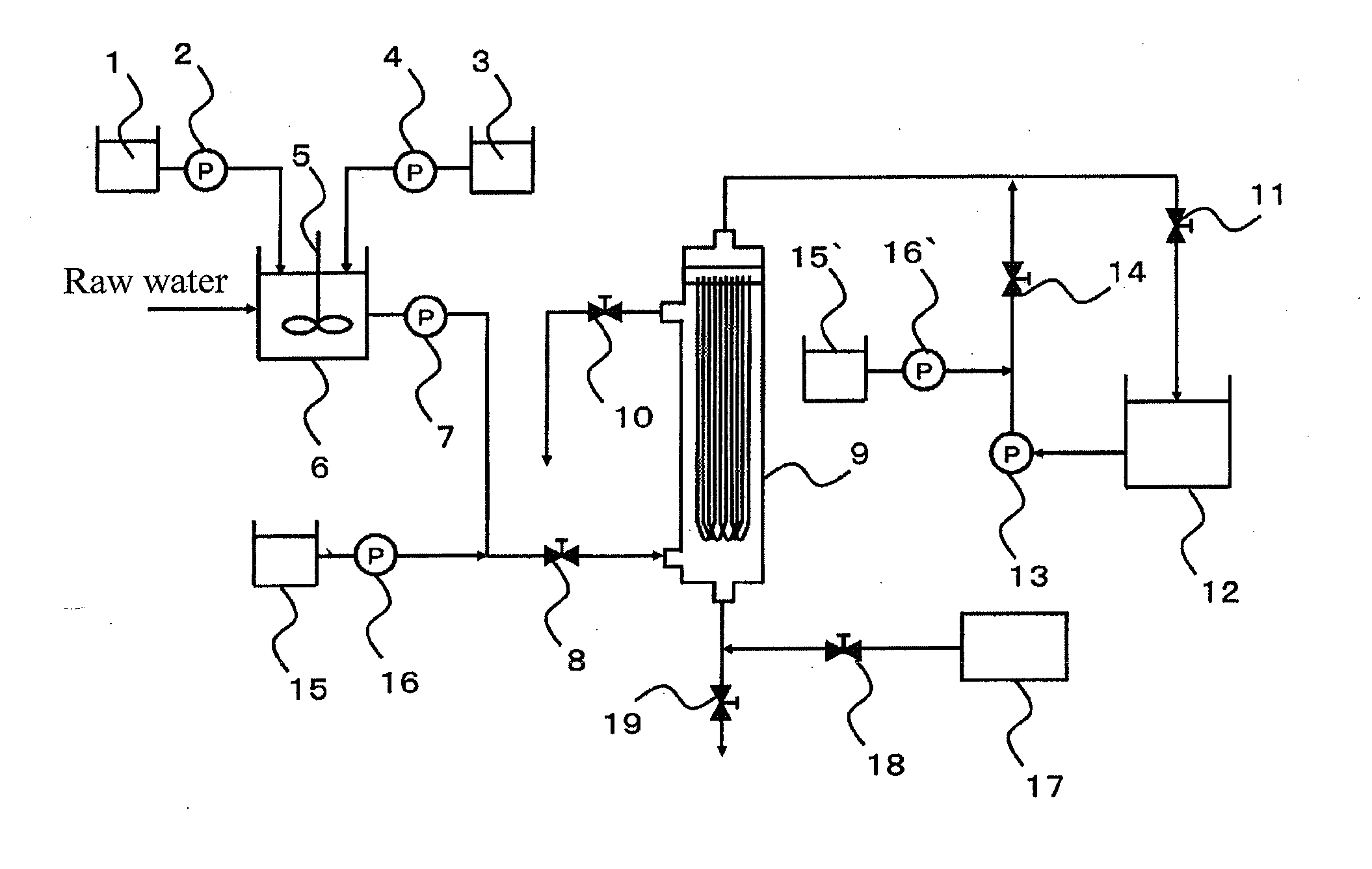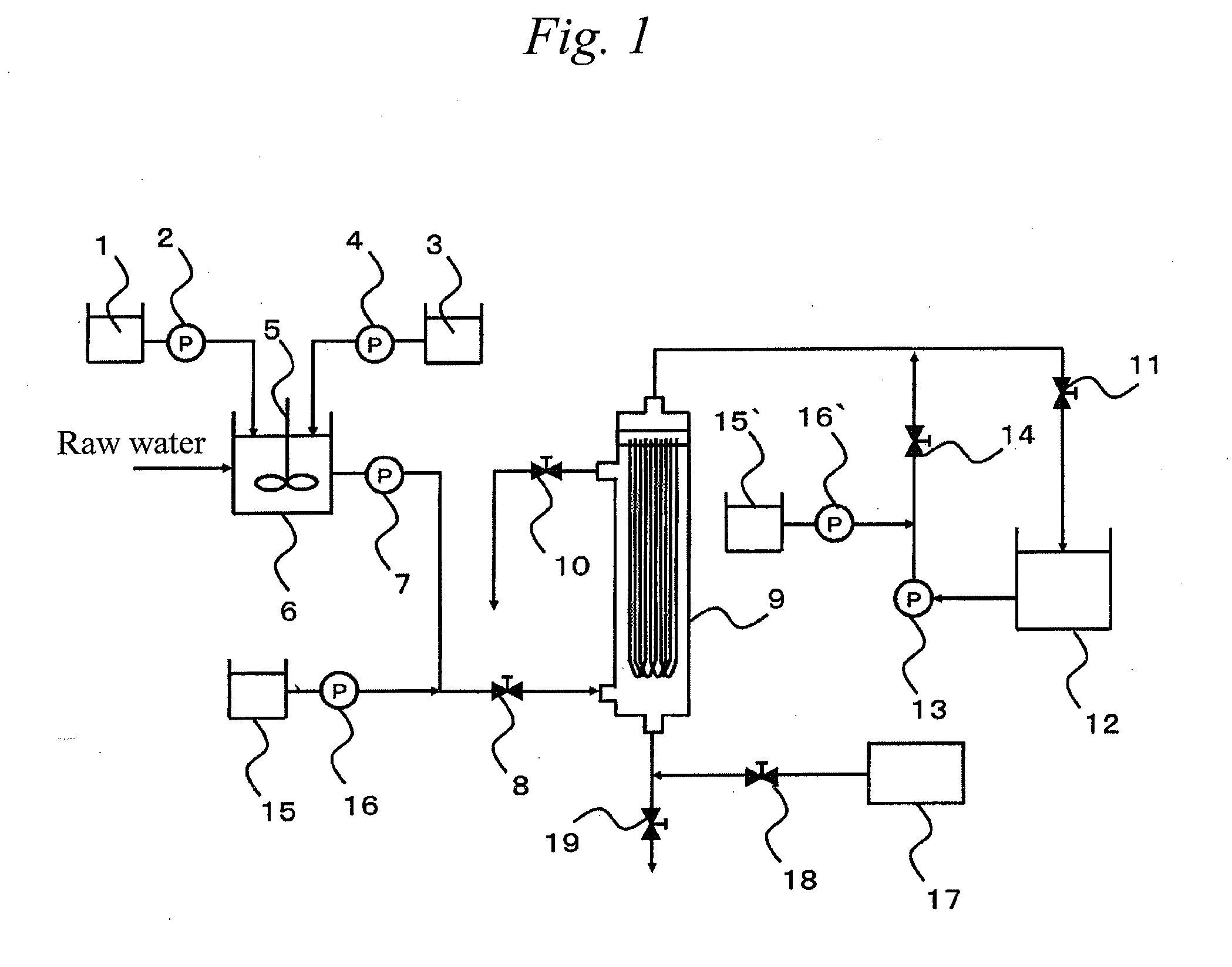Washing method for separation membrane module
- Summary
- Abstract
- Description
- Claims
- Application Information
AI Technical Summary
Benefits of technology
Problems solved by technology
Method used
Image
Examples
example 1
[0072]In an apparatus shown in FIG. 1 using one module of an external pressure type PVDF ultrafiltration hollow fiber membrane module HFU-2020 (manufactured by Toray Industries, Inc.), river water in which addition concentration of powdered activated carbon had been adjusted to 50 mg / L and addition concentration of polyaluminum chloride had been adjusted to 1 mg-Al / L in a flocculation reaction tank 6 was subjected to constant flow rate filtration at a membrane filtration flux of 1.5 m3 / (m2·d) by opening the flocculation water feed valve 8 and the filtrate valve 11 and bringing the slurry feed pump 2, the flocculant feed pump 4, the stirrer 5, and the flocculation water feed pump 7 into operation. Here, hardness of the hollow fiber membrane was 0.019 GPa and hardness of the powdered activated carbon was 2.3 GPa.
[0073]After 30 minutes from the start of the constant flow rate filtration, the flocculation water feed valve 8 and the filtrate valve 11 were closed and the flocculation wate...
example 2
[0075]This example was performed in the same manner as Example 1 except that the chelating agent feed pump 16 was brought into operation to fill the membrane primary side in the microfiltration membrane / ultrafiltration membrane module 9 with a 0.1% aqueous citric acid solution whose pH had been adjusted to 5 with sodium hydroxide and then the chelating agent feed pump 16 was halted, followed by settlement for 10 minutes in the step b.
[0076]As a result, the transmembrane pressure of the microfiltration membrane / ultrafiltration membrane module 9 was still 31 kPa after 6 months versus 15 kPa just after the operation start, so that stable operation could be performed. Moreover, as a result of performing chemical cleaning with a 0.3% aqueous sodium hypochlorite solution and a 3% aqueous citric acid solution after the operation for 6 months, the pure water permeation performance of the microfiltration membrane / ultrafiltration membrane module 9 was restored to 96% as compared with the time...
example 3
[0077]This example was performed in the same manner as Example 1 except that the chelating agent feed pump 16 was brought into operation to fill the membrane primary side in the microfiltration membrane / ultrafiltration membrane module 9 with a 0.1% aqueous citric acid solution whose pH had been adjusted to 7 with sodium hydroxide and then the chelating agent feed pump 16 was halted, followed by settlement for 10 minutes in the step b.
[0078]As a result, the transmembrane pressure of the microfiltration membrane / ultrafiltration membrane module 9 was still 29 kPa after 6 months versus 15 kPa just after the operation start, so that stable operation could be performed. Moreover, as a result of performing chemical cleaning with a 0.3% aqueous sodium hypochlorite solution and a 3% aqueous citric acid solution after the operation for 6 months, the pure water permeation performance of the microfiltration membrane / ultrafiltration membrane module 9 was restored to 97% as compared with the time...
PUM
 Login to View More
Login to View More Abstract
Description
Claims
Application Information
 Login to View More
Login to View More - R&D
- Intellectual Property
- Life Sciences
- Materials
- Tech Scout
- Unparalleled Data Quality
- Higher Quality Content
- 60% Fewer Hallucinations
Browse by: Latest US Patents, China's latest patents, Technical Efficacy Thesaurus, Application Domain, Technology Topic, Popular Technical Reports.
© 2025 PatSnap. All rights reserved.Legal|Privacy policy|Modern Slavery Act Transparency Statement|Sitemap|About US| Contact US: help@patsnap.com


